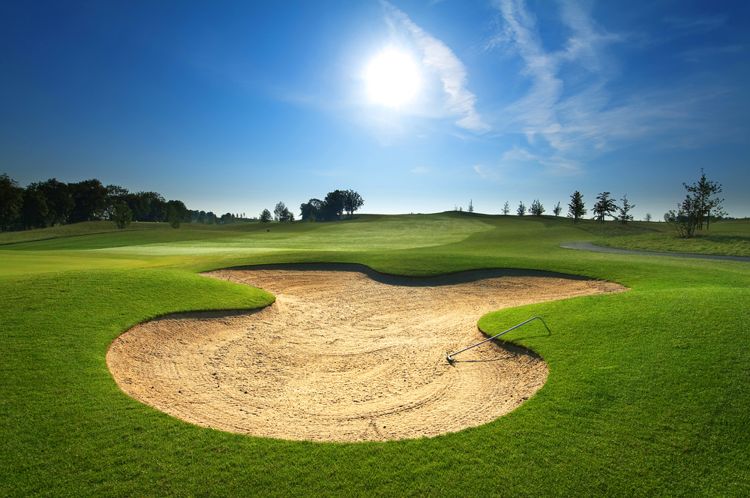Does driving distance matter?
Is your New Year’s resolution to increase your driving distance? Perhaps giving up carbs might seem more likely at this point, especially if you’ve had a bad round recently. The point is most people want to reduce the average shots taken per round over the year. Who doesn’t? But playing closer to par and not losing your rag every time you slice a shot is extremely difficult. Granted, it’s much easier to give in to your emotions and launch your clubs away in fury. So think about your goal. Is your driving distance letting you down or is it your consistency? A resolution is just words, so how does that translate into better scores? Specify what you are going to do to achieve your goals.
There’s an issue bothering us about game improvement. And that's the question of distance or consistency. What should your focus point in practice be and what truly makes the difference?

Photo Credit: Debby Wong / Shutterstock.com
Driving distance or consistency, what matters most?
The pros are now hitting longer drives off the tee than ever before, with a quarter of the field averaging over 300 yards last season. We know there have been huge strides in club technology and ball development since the early 2000s with some impressive new golf club releases this year. And new championship courses are getting longer with old courses adding yardage to some of our most loved holes. So you could say the emphasis is on distance. There’s something special about top athletes. And when we see a long bomber like Bubba Watson crush his drive over 350 yards, we can’t help but be in awe. Take this 424 yard belter from 2014 at the WGC Bridgestone Invitational.
And with huge drives being made week in, week out on the Tour, it’s only natural to want to follow form and unleash the beast like Bubba. Although you don’t have to be a big hitter to win big, and Jordan Spieth is a great example of this. He placed tied 43rd last season for driving distance, but won 5 Championship events and took the FedEx Cup trophy. So big hitters don’t necessarily win tournaments. Only two players out of the top ten biggest hitters at The Masters placed in the top ten for the final round. Jason Day was the only Major winner to come close to leading the field in driving distance and winning a Major last year, being the third longest hitting that week. So consistency is just as vital if not more so for professional players.
On the Tour, professional event winners tend not to be long bombers as the rest of their game overall is better and more consistent around the pin.
Nonetheless, the truth is many amateur golfers aren’t good drivers of the ball. Driving is a very hard skill to master, and can take years to perfect. And if it isn't helping professionals win tournaments in the competitive arena then maybe we should question the importance of driving distance in itself. The question is does it provide that much of an advantage to make it worth countless training hours, stress and all those lost balls?
Once upon a time on a fairway
Over the Christmas break, on an unusually dry, sunny morning the guys from the shop played at a local par 70 course (6,220 yds). There were 3 or 4 holes nearing 460 yards in distance, meaning there was ample opportunity to get the big sticks out and let rip. However, one of the players amongst us preferred to take a 5 iron to the longer tees instead of a driver because he knew his driving game wasn’t good. One hole in particular stuck in our minds. The third hole was a 446 yard, par 4, straight shot uphill from tee to flag.

Image Credit: VojtechVlk / Stutterstock
The first guy brandished his driver and with an almighty swing caught the ball off line sending it sailing into the trees lining the near side. He replaced his ball and took another tee shot with a 4 iron and made 150 yards, taking a two shot penalty from the tee. Our second guy had a more successful drive shooting his ball slightly off-centre, coming to rest on the fairway roughly 190 yards from the tee. The last guy hit the ball nice and clean with his Nike 5 iron, without trying to overdo it like he might have with a driver, making 175 yards and landing just short of his previous playing partners driven ball on the fairway. After that, the first guy two putted the green and scored a poor three over par. His driving consistency was the issue, restricting his overall distance. Had he taken the iron tee shot in the first place and two putted the green (assuming he would have two-putted regardless of the negative affect a poor drive was playing on his mind), he would have made only 1 over par. The other two players made it to the green in three and putted for par.
This single hole really made the case that you don’t have to try or necessarily hit massive drives to make good scores. With a consistent iron game, you can achieve equally similar results. Where a player can drive a ball over 200 yards more often than not, and can make a considerable extension on their iron shots then driving from the tee is indeed worthwhile. Even so, with the wide variety of things that can go wrong with a drive, is that extra 20 or 30 yards really worth the risk of losing your ball, topping it or just mishitting it?
It’s a tough dilemma, and there’s no doubting the satisfying ‘clink’ of your driver’s face as it vaporises your ball into the clouds. But you have to ask yourself, how often does that actually happen? If the answer is not enough, then you know what you should be doing. And it’s no mystery how a bad driving day messes with your head. Playing from trouble wears you down quickly, so consider how often you can hit fairways and greens in regulation from your drives. It's much better to go round the fairways in one or two extra shots because you didn't hit the ball as far, than hitting it further and playing from the rough.
Can't drive, won't drive
One good solution is to allow one extra shot to the specified par of every hole on the scorecard. This gives you an extra shot per hole to finish. And if you actually do it, then 18 over on a par 70 course is not a bad score at all. This of course is all relative to your handicap and what level player you are, (if you can hit a driver 200 yards no problem and regularly hole-out on or under par, then congratulations and please ignore us).
For the rest of us the problem remains. Do you go the distance or do you shunt your ego and take a reliable iron tee shot? Surely it’s not all about how close you hit it to the hole, it’s also how well you putt once you get there. At the end of the hole, your putting must be good enough to exploit any yards you may have gained on your opponents. So why is the driver, the club that matters the most? The real question perhaps should not be of your driving at all.
What the professionals say
Lets’ take a look at what people who have been in and around the sport for decades think;
Yuji Numazawa, a famous Japanese club designer, thinks that “40% of a players score comes from their skills on the green” and with over 30 years’ experience working for the likes of Bridgestone and many other top golf club manufacturers he’s probably not wrong. He may be slightly biased in his outlook, as he recently released some of the most expensive putters on the planet, but his philosophy is more than a sales pitch. Put simply, there’s no point in hitting a huge drive if you can’t finish it off on the putting green.
Sam Snead’s infamous phrase “Drive for show, putt for dough” has left as much of a mark in golf history as he has, but University Professor at Columbia University, Mark Broadie disagrees with the longstanding analogy. Broadie believes “The long game explains about two-thirds of scoring” and that good putting has been overvalued for far too long. In his book titled Every Shot Counts he explains if a pro shoots three over par on a day where par is the average, and loses a stroke to the field putting; where are the other three strokes lost? The only other place he or she can lose them is from tee to green.
Worldwide Director of instruction for Nicklaus Academies, Mike Malaska says "You don’t have to hit it that far. Distance, in and of itself, does not make you a better player, even though hitting a driver a long way is what the average amateur wants to learn to do." And he makes a good point, amateurs seem to have an unwavering magnetism to learn how to hit a driver a long way. But as Mike notes "Never hitting it more than 150 yards and always being in the fairway is a lot more important than trying to hit it 300 yards and being in the trees" Malaska said. So all in all, we tend to agree with Mike. But we should add that you should take the approach that will give you the most enjoyment out of your game. If scoring lower shots per round is your goal and the sense of achievement in doing so is your bag then seeking to improve your overall consistency is best suited. If you just want to whack it and don't really care about the end result then practice your driving. If you want an all-rounded game where you can pick up a few extra yards and make better scores then we've outlined a good approach below.
How?
The pros use ShotLink technology to scrutinise every inch of their on-course performance, from the tees to the greens, but stats aren’t just reserved for pros, they are a great way for golfers of all levels to improve.

Four fundamentals amateur golfers can track to make small improvements to their overall performance are:
1. Fairways hit
2. Greens in Regulation
3. Putts per hole
4. Scrambling
By using these four parameters, players can focus on making small improvements to their numbers instead of wasting energy on technique or perfecting their swing. These are only separate factors in a golfer’s overall game, instead of concentrating on single elements, we believe golfers don’t necessarily need to work on their swing. The swing you have cannot change that much, yes, you can work on ball alignment and hand positioning, but with statistics the emphasis is switched to the end goal not the mechanics. Freeing you up to apply your efforts to completing more meaningful tasks like hitting fairways and increasing your greens in regulation percentage.
At the end of the day, golfers are golfers for pretty similar reasons. We like what we see and we want to recreate the spectacular. From the heydays of Tiger Woods to show-stopping moments of perfection on the Tour that give subtle glimpses of greatness. Golf is a pursuit of happiness, with many failures and much fewer pinnacles. A quote from Arnold Palmer just about sums it up “What other people may find in poetry or art museums, I find in the flight of a good drive.” And that’s the long and not so short of it. How you play is up to you.
Feature Image Credit: LuckyImages /Shutterstock






